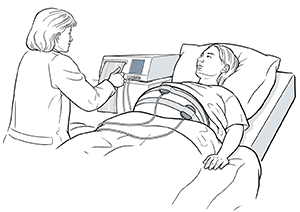Fetal Monitoring - Fetal Movement Assessment (How Your Baby Is Doing)
Identifying and correcting problems may prevent serious problems from developing with the fetus, including fetal loss. Some pregnancies are complicated by the mother's medical problems. Some of these problems are type 1 diabetes mellitus, high blood pressure and other chronic medical illnesses. This is why it is important to monitor the baby before birth.
There are several very serious problems that cannot be predicted or detected with any of the fetal monitoring procedures. These problems include separation (abruption) of the placenta or when the fetus chokes on the umbilical cord (umbilical cord accident). Your caregiver will help you understand your tests and what they mean for you and your baby. It is your responsibility to obtain the results of your test.
Techniques of Monitoring Your Baby Before Birth:

Several tests are in use. These include:
- Fetal Movement Assessment:
Fetal Movement Assessment (FMA) is done by the pregnant woman herself by counting and recording the baby’s movements over a certain time period. It is done to see if there are problems with the pregnancy and the baby. Sometimes, a mother notices her baby moves less before there are problems. Because of this, it is believed that fetal movement checking by the mother (kick counts) is a good way to check the baby before birth.
The woman lies on her side and counts distinct (individual) fetal movements. A feeling of 10 distinct movements in a period of up to 1 hour is considered reassuring. When 10 movements are felt, you may stop counting. Try to measure fetal movements at the same time every day. There are no risks or complications to the mother or fetus with FMA.
This test monitors the baby’s heart rate when the baby moves.
- Contraction Stress Test (CST):
This test monitors the baby’s heart rate during a contraction of the uterus.
- Fetal Biophysical Profile (BPP):
This measures and evaluates 5 observations of the baby:
- The nonstress test.
- The baby’s breathing.
- The baby’s movements.
- The baby’s muscle tone.
- The amount of amniotic fluid.
This measures the volume of fluid in different parts of the amniotic sac (amniotic fluid index) and the results of the nonstress test.
- Umbilical Artery Doppler Velocimetry:
This evaluates the blood flow through the umbilical cord.
Preparation For Test:
- Do not take medications that may decrease or increase the baby’s heart rate and/or movements.
- Eat a full meal at least 2 hours before the test.
- Do not smoke if you are pregnant. If you smoke, stop at least 2 days before the test. It is best not to smoke at all when you are pregnant.
- Any medications you are taking including prescription and over-the-counter drugs, herbs, eye drops and creams.
- If you have a fever.
- If you have an infection.
- If you are sick.
Home Care Instructions:
- Follow your caregiver’s advice and recommendations.
- You may resume your usual activities.
- Be aware of your baby’s movements. Are they normal, less than usual or more than usual?
- Make and keep the rest of your prenatal appointments.
Seek Medical Care If:
- You develop a temperature of 100.4º F (38º C) or higher.
Seek Immediate Medical Care If:
- You do not feel the baby move.
- You think the baby’s movements are too little.
- You develop vaginal bleeding.
- You have belly (abdominal) pain.
- You have leaking or a gush of fluid from the vagina.